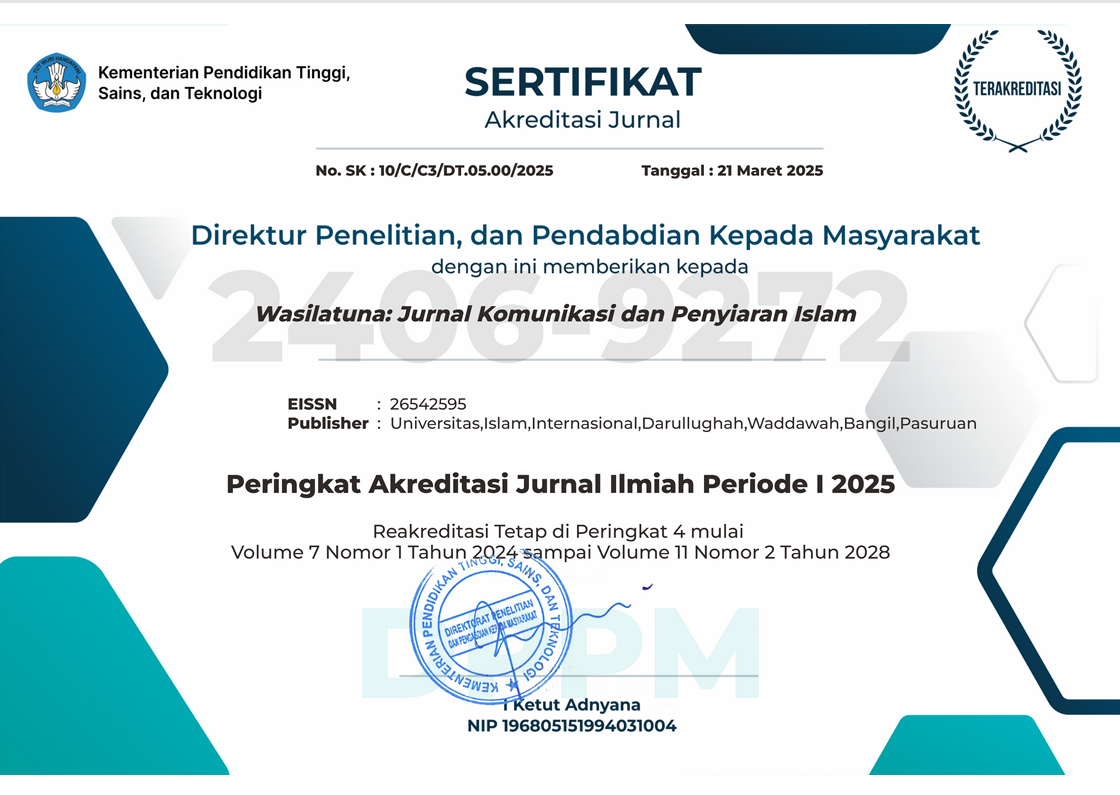COMMUNICATION STRATEGY OF AS-SUNNAH ISLAMIC BOARDING SCHOOL IN RESTORING ITS IMAGE AFTER IDENTITY CONFLICT IN BAGIK NYAKE
DOI:
https://doi.org/10.38073/wasilatuna.v6i02.1016Keywords:
Communication Strategies, Image, Identity ConflictAbstract
The objectives of this research were, (1) to be able to explain the situation of the As-Sunnah Islamic boarding school after the identity conflict in Bagik Nyake. (2) To be able to analyze the communication strategies of the As-Sunnah Islamic boarding school after identity conflict in Bagik Nyake. This research used qualitative approach with type of case study. Data collection was carried out by using observation, interview and documentation techniques. The intensive research process was carried out almost a year involving various informants consisting of Islamic boarding school leaders, teachers, students of the As-Sunnah Islamic boarding school in Bagik Nyake and the community. The results of this research showed that the situation of the As-Sunnah Islamic boarding school after identity conflict with the community was as usual the students directly continued their school and various Islamic boarding school activities also continued. The communication strategies carried out by the As-Sunnah Islamic boarding school in restoring its image after identity conflicts were by (1) the relationship function, namely discussing with the community by attending each other's activities but still without leaving the sunnah of Rasulullah PBUH. (2) The education function, namely combining the general curriculum and the Islamic boarding school curriculum. (3) the persuasion function, namely conducting studies every Tuesday night, Tabligh Akbar activities with interviewee from the Middle East and publishing various Islamic boarding school activities on social media such as Facebook, so that this could improve or increase the good image of the As-Sunnah Islamic boarding school. (4) problem solving, namely by convincing the students’ parents and the community that Islamic boarding school is the right Islamic boarding school for their children in terms of religious learning in accordance with what was taught by Rasulullah PBUH.
Keywords: Communication Strategies, Image, Identity Conflict.
Downloads
References
Bungin, Burhan. “Sosiologi Komunikasi.” In Kencana Prenada Media Group, Jakarta, 2009.
Cangara, Hafied. “Perencanaan & Strategi Komunikasi.” In PT Rajagrafindo Persada, Jakarta.,
Fadli, Adi. “Intelektualisme Pesantren; Studi Geneologi Dan Jaringan Keilmuan Tuan Guru Di
Lombok.” El-Hikam : Journal of Education and Religious Studies IX, no. 02 (2016): 287–
Faizah. “Gerakan Salafi Di Lombok.” Harmoni 11, no. 4 (2012): 56–68.
Karsono, Purwanto, and Abdul Matin Bin Salman. “Strategi Branding Dalam Meningkatkan
Kepercayaan Masyarakat Terhadap Madrasah Tsanawiyah Negeri.” Jurnal Ilmiah Ekonomi
Islam 7, no. 2 (2021): 869–80. https://doi.org/10.29040/jiei.v7i2.2649.
Malik, Abdul. “Jaringan Intelektual Dan Ideologi Pesantren Salafi Jihadi: Studi Pada Daerah
‘Zona Merah’ Terorisme Di Bima.” Ta’allum: Jurnal Pendidikan Islam 6, no. 2 (2018):
–40. https://doi.org/10.21274/taalum.2018.6.2.
Mukri, Syarifah Gustiawati. “Modernisasi Sistem Pendidikan Pesantren.” Fikrah: Jurnal Ilmu
Aqidah Dan Studi Keagamaan 15, no. 1 (2016): 165–75.
https://core.ac.uk/download/pdf/196255896.pdf.
Nurjaman, Kadar, and Khaerul Umam. Komunikasi & Public Relation. CV. Pustaka Setia,
Bandung, 2012. ???
Robbani, Muhammad Imdad. “Salafiyah: Sejarah Dan Konsepsi.” Tasfiyah : Jurnal Pemikiran
Islam 1, no. 2 (2017): 245–76. https://doi.org/10.21111/tasfiyah.v1i2.1853.
Ruslan, Rosady. Manajemen Public Relation Dan Media Komunikasi. PT. Rajagrafindo
Persada : Jakarta, 2007.
Stiawan, Kelik, and M Tohirin. “FORMAT PENDIDIKAN PONDOK PESANTREN SALAFI
DALAM ARUS PERUBAHAN SOSIAL Di KOTA MAGELANG.” Cakrawala 10, no. 2
(2015): 194–209.
Suhilman. “Sejarah Perkembangan Pemikiran Gerakan Salafiyah.” Jurnal Islamika : Jurnal Ilmu Ilmu Keislaman 19, no. 01 (2019): 70–80. https://doi.org/10.32939/islamika.v19i01.414.
Ubaidillah, Adhis. “Konsep Dasar Komunikasi Untuk Kehidupan.” Al-Ibtida’ 4, no. 2 (2016): 30–54.

Downloads
Published
Issue
Section
License
Copyright (c) 2023 Siti Rahmatullah, Fahrurrozi, Abdul Malik

This work is licensed under a Creative Commons Attribution 4.0 International License.







